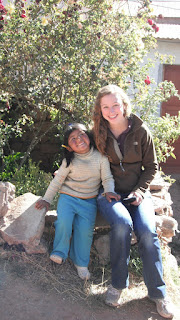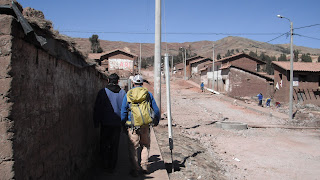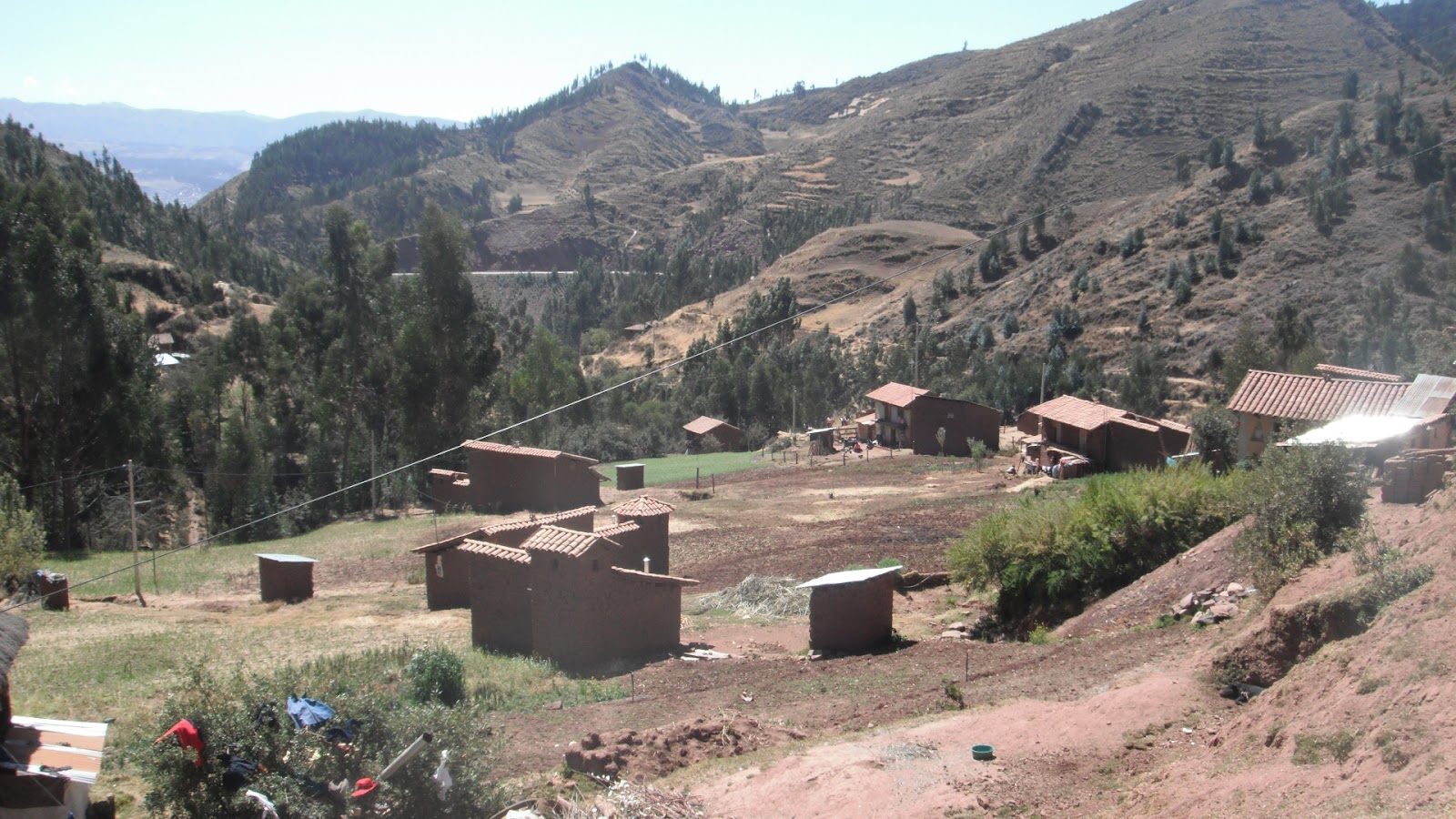The islands are made from these reeds
View of the Uros Islands
Explaining how the base of the island is created
Inside of a house
After spending a few hours on the Uros Islands, we headed over to Amantaní Island, one of the four largest islands in Lake Titicaca. We arrived around 1pm, where we were assigned "host families" that would feed and house us until the next day. Hannah and I were in a family with a mom, dad, and two daughters. The youngest daughter, Pilar, was four years old and quite a spunky, adorable girl!
Amantaní Island
Our host family
Pilar
Lunch of boiled potatoes, oka, and grilled cheese
That evening, our group hiked up to the top of the island. We watched the sunset from there, and also got some incredible views of the lake.
A stone wall near the top of the island
When we got back, our host families dressed us up in traditional Peruvian clothes, and took us to a building on the central plaza to dance. I think I would have enjoyed this more if I had gotten more than 2 hours of sleep the night before....
The following day began bright and early at 6am, since we had a 3 hour journey by boat to get to Taquile Island. Once we arrived, we walked for about an hour to the central plaza, and then another 45 minutes or so to the top of the island. Here, we were given another talk about the culture and lives of those living on these islands.
From here, we walked back down into town, ate lunch at a local restaurant, and then began the boat ride back to Puno. After the tour was over (around 4pm), Hannah and I walked around town for a while before eating a delicious dinner of alpaca steak and lomo saltado (a traditional Peruvian dish).
I then had to say goodbye to Hannah, since she was staying the night in Puno, traveling to Arrequipa the following morning, and then making her way to Lima to fly home. I took another overnight bus back to Cusco, and was fortunately able to sleep much better this time. I arrived a little before 5am, took a taxi back to my apartment, and slept a little while longer before getting up to work at Occopata that morning. Needless to say, I was fairly exhausted.
On Tuesday, Michael and I went up to Occopata to do some health campaigns in the schools. We first visited the Jardín, where we had originally treated the kids for scabies a few months ago. It was really great to see how so many of the children who were previously infected are now healthy! We also brought up wart treatment, and administered it to those who needed it. Afterwards, we all played jump rope with the kids, and then had tea and cookies in the classroom. The kids also gave Michael and I presents - egg cartons with a picture of a chicken on it :)
We then headed back to the clinic to enjoy some chocolate cake that Michael and I had brought up since it was one of my last days at Occopata.
That afternoon, we went to the elementary/high school to give a presentation on alcohol and alcoholism, a huge problem in Occopata. Many of the fathers in Occopata are alcoholics and abuse their wives and children, which is really sad. After I leave, Michael will continue to give this presentation in different classes.
A few of the kids also had warts, and so we treated them as well.
Getting my hair braided by three girls who were fascinated with its color/texture.
The next day, we all got up very early to do house visits in the community of Mayrasco, which is below Occopata. I really enjoyed this, because we got to hike around in the mountains far above Cusco. The people who live far up in the mountains rarely come down to Cusco or go up to the health clinic in Occopata, and so the doctor and nurses have to walk to their houses. On Wednesday, the main purpose of our visits were to inform those who don't have health insurance that they need to go down to Cusco and fill out the necessary paperwork in order to obtain insurance. The insurance only costs about 10 dollars, but this is still a substantial amount of money for most of these people.
Wednesday was my last day of volunteering, since I needed a few days to get ready to travel to Ecuador. I leave early tomorrow morning, and will be in Quito by 4 pm to meet the rest of the students in my study abroad program! I currently have very conflicting feelings about leaving Cusco - I have absolutely loved my three months spent here, and consider them some of the most eye-opening and rewarding months of my life. But at the same time, I can't wait to move on to Ecuador, live with a host family and study in Quito with other students.
I will be continuing my blog in Ecuador, but as I will be a full time student, my blogs might become shorter and less frequent. I hope that this doesn't happen, but I know I will be gone for weeks at a time on ecological excursions and I may not have internet in my host family's home. I would like to thank everyone who has been reading my blog and supporting me during my time in Cusco - I love hearing your thoughts and insights through emails and comments in response to my blog posts.
When I get to Ecuador, our orientation begins immediately, and lasts about a week. Following this, we are going on a week-long excursion to the Intag cloud forest, so I won't be in contact much for the next two weeks. I hope you've been enjoying my blog for this first half of my journey, and I look forward to what the next four months bring!




































































